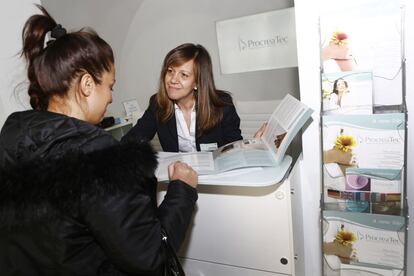Why Spain is an increasingly attractive destination for fertility tourism
Thousands of foreigners are coming to the country to visit clinics – and the beach

The plan: a vacation on the Spanish coast – or else a tour of Madrid and its landmarks – a visit to the fertility clinic, and hopefully a return home with a baby growing inside.
Spain is a reference in Europe when it comes to assisted reproduction: 40% of all treatments carried out on the continent are performed here, according to the European Society of Human Reproduction and Embryology (ESHRE).
“And this trend will keep growing,” says this body.
Online messages can reach every corner of the Earth, and have been key in the international development of Spanish clinics Laura Alonso, ProcreaTec Clinic
There are no specific figures for a type of visitor whom Spanish tourism authorities currently classify under “Tourism: Other,” along with people who come for purposes such as hunting, running or yoga.
Between January and February, there were 7.2 million visitors to Spain, of whom 952,930 fell under this category, which excludes recreational and business tourism.
“I am writing to you from a very, very remote town in Australia...” begins an email that arrived recently at a Madrid fertility clinic named ProcreaTec.
Sign up for our newsletter
EL PAÍS English Edition is launching a weekly newsletter. Sign up today to receive a selection of our best stories in your inbox every Saturday morning. For full details about how to subscribe, click here.
“Word of mouth works,” says Laura Alonso, head of the clinic’s communications department. “And these days, word of mouth takes place online, through messages posted on forums, social media and so on. Those messages can reach every corner of the Earth, and have been key in the international development of Spanish [fertility] clinics.”
The center where Alonso works opened in 2008, “with the crisis in full swing.” Because of falling numbers of Spanish clients, managers were forced to look abroad for new customers. Aided by technology, they have managed to build up a database in which half of their patients hail from other countries.
“Between 2014 and 2015 there’s been an 18% rise in international [assisted reproduction] cycles,” she adds.
The rates are similar at other Spanish clinics, including IVI, the country’s largest such center.
The first contact is usually through email. After chatting with the patient-care team in German, English, Italian or French, the conversation moves on to a video conference.
The couples only show up physically at the end, when the embryos are inserted into the woman’s uterus.
But someone who is coming all the way from Australia to Spain is not going to stay for just two days, especially not in one of the world’s top tourist destinations, which had over 65 million visitors last year.
“People began demanding vacation experiences,” explains the ProcreaTec spokeswoman. “We don’t organize holiday packages ourselves, but we do put patients in touch with tour operators or hotels.”
For the first time this year, the International Medical Travel Summit, one of the world’s best-known health tourism gatherings, will be held in Madrid rather than in Britain.
“People choose Spain as a reproductive tourism destination because their own countries have legal limitations that do not favor assisted reproduction,” says Enrique Criado, who heads the Marbella-based center FIV.
The rise of this kind of tourism can be explained by Spain’s protective legislation, its good reputation in the field of assisted reproduction, its high success rates and its reasonable prices (between €600 and €6,000 depending on the treatment).
And it all becomes even more attractive if patients are given the chance to combine the treatment with several days of sun and sand.
English version by Susana Urra.
Tu suscripción se está usando en otro dispositivo
¿Quieres añadir otro usuario a tu suscripción?
Si continúas leyendo en este dispositivo, no se podrá leer en el otro.
FlechaTu suscripción se está usando en otro dispositivo y solo puedes acceder a EL PAÍS desde un dispositivo a la vez.
Si quieres compartir tu cuenta, cambia tu suscripción a la modalidad Premium, así podrás añadir otro usuario. Cada uno accederá con su propia cuenta de email, lo que os permitirá personalizar vuestra experiencia en EL PAÍS.
¿Tienes una suscripción de empresa? Accede aquí para contratar más cuentas.
En el caso de no saber quién está usando tu cuenta, te recomendamos cambiar tu contraseña aquí.
Si decides continuar compartiendo tu cuenta, este mensaje se mostrará en tu dispositivo y en el de la otra persona que está usando tu cuenta de forma indefinida, afectando a tu experiencia de lectura. Puedes consultar aquí los términos y condiciones de la suscripción digital.
More information
Archived In
Últimas noticias
Most viewed
- Pablo Escobar’s hippos: A serious environmental problem, 40 years on
- Why we lost the habit of sleeping in two segments and how that changed our sense of time
- Charles Dubouloz, mountaineering star, retires at 36 with a farewell tour inspired by Walter Bonatti
- Reinhard Genzel, Nobel laureate in physics: ‘One-minute videos will never give you the truth’
- The Florida Keys tourist paradise is besieged by immigration agents: ‘We’ve never seen anything like this’











































